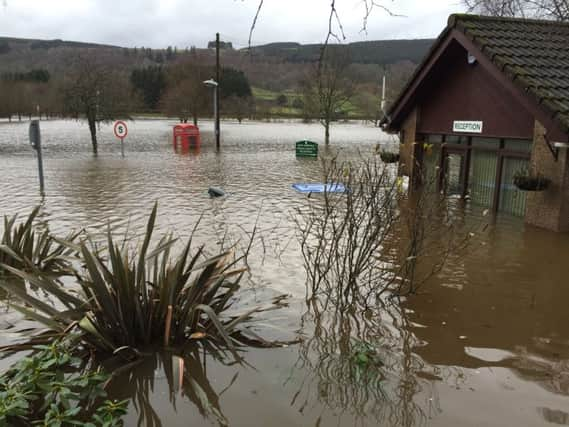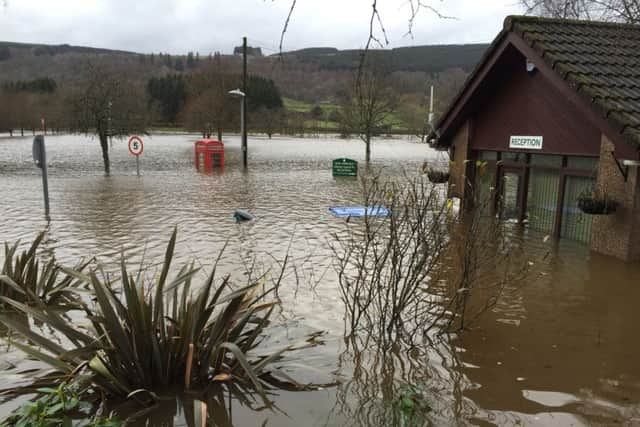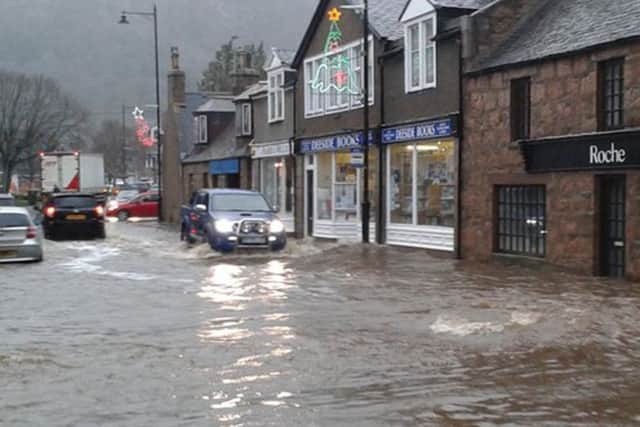Scotland’s weather: Storm Frank to cause Hogmanay misery


Aberdeenshire, Ayrshire and Dumfries and Galloway bore the brunt of the extreme weather with thousands of homes were evacuated and left without power.
Yesterday about 6,000 homes were still without electricity as repair efforts were hampered by rain and winds of up to 90mph.
Advertisement
Hide AdAdvertisement
Hide AdIn Ballater, where 1,500 homes lost their supply, engineers were unable to gain access to a substation because of flooding in the village.
Many properties are expected to remain cut off over Hogmanay and into the New Year.
Eight adults and two children, aged seven and five, were winched to safety by a rescue helicopter after a Stagecoach bus became trapped near Dailly, Ayrshire.
A further two adults were taken off the coach by officers from Police Scotland’s marine unit.
Shona Kirkwood, 49, described the drama as rising flood waters from the River Girvan lapped around the stranded bus with the passengers still inside. She said: “You could see the water was up to the windows so it must have been absolutely terrifying for the people on the bus.


“A wall collapsed and that made it even worse, with water over the fields and in front gardens.”
Floodwater also inundated Whitesands at Dumfries for the third time this winter and homes and families had to be evacuated at Newton Stewart.
In the Cree Valley more than 120mm of rain was recorded in a 12-hour period, and 11 coastal flood warnings for the Solway Firth were issued because of high tides and gales that reached 70mph along the coast.


Advertisement
Hide AdAdvertisement
Hide AdThe River Nith at Dumfries was around 4m higher than normal and a tidal surge in the early afternoon saw floodwater reach nearly 2m in places – the highest for many years.
Key routes including the M8 and the M74 had lanes and junctions shut due to surface water.
The A77 south of Girvan at Maybole in Ayrshire was closed due to surface water.
In East Ayrshire, travellers were asked to avoid New Cumnock and there were reports of cars stuck in water at Newark roundabout in Port Glasgow, Inverclyde.
A landslide forced the closure of the A83 at Rest and Be Thankful, while flooding shut the A85 at Crianlarich. Elsewhere, a kayaker had to be rescued after getting into difficulty in the River Findhorn.
The Scottish Government’s resilience committee met to assess the response to what environment minister Aileen McLeod described as a “very serious situation”.
Dumfries and Galloway Council deployed its major emergency response scheme for the second time this month and the Scottish Environment Protection Agency (Sepa) issued its highest flood alerts for Whitesands and Newton Stewart, where floodwaters raged into the town centre, knocking out telephones and flooding the police station.
More than 2,000 homes and shops were left without power and a rest centre was set up at a school on the outskirts of the town.
Advertisement
Hide AdAdvertisement
Hide AdNew Galloway and Carsphairn in the Glenkens area of the Stewartry were also badly flooded, with all roads in and out closed by deep water.
More than 30 homes at Carsphairn had to be evacuated because of the rising waters and firefighters using boats managed to get families out of their homes.
In Dumfries, shopkeeper Rab Smith had to abandon his business on Whitesands as the waters rose.
“If I hadn’t got out then I would have been stuck there for a few hours,” he said.
“The water is into the shop and although I got sandbags and have a barricade the water still came through.
“This is the fifth time I’ve been flooded this year.”
He added: “We have 48 businesses hit today on the Whitesands, and it takes days to clear up. I’ve lost my phone, my electrics and the carpets will all have to be cleaned.
“We can’t get insurance now. We used to get it but they just don’t want to know us now.
“This is one of the worst years. I’ve been there for 30 years and at first it was a flood every four or five years, now it’s four, five and six a year.”
Advertisement
Hide AdAdvertisement
Hide AdShopkeepers and publicans tried pumping the water out and some used buckets.
One woman, who was evacuated by boat, said: “We didn’t think it was going to get as bad as this.
“It was frightening as the waters rose and it was good to get out. We don’t know what to expect when we are allowed back.”
Emergency services were called out to rescue 12 people who became stranded on a bus after it was engulfed in a massive flood in the Ayrshire village of Dailly.
Jacqueline Hendry, who was at the scene, said: “I was passing in my car when I saw a lot of ambulance, fire and police.
“The bus was near enough submerged and the road was closed,
“I’m not sure if the driver maybe hasn’t been told, but it has led to quite a grim result.
“The road runs alongside the River Girvan, which has burst its banks and the bus looked like it had been pushed into the water.
“There were people still on board, and the bus was in almost complete darkness.”
Advertisement
Hide AdAdvertisement
Hide AdMost of the country was on flood alert, with more than 100 warnings in force across Scotland. Sepa also issued two orange “danger to life” warnings of severe flooding for the rivers Nith in Dumfries and Galloway and the Tweed in the Borders.
Numerous properties had to be evacuated due to danger from rising floodwaters.
Residents of Ballater in Aberdeenshire were forced to flee after the River Dee overflowed, while the fire service was called in to help villagers in Straiton, South Ayrshire, to leave their homes.
Travel on motorways and rural routes alike was severely disrupted by surface water and landslips, with motorists being urged to avoid unnecessary journeys.
Flooding forced the closure of roads across the regions, with rail and ferry services also affected.
Meanwhile, Glasgow’s busy Great Western Road was partially closed near Gartnavel Hospital due to “severe flooding” and Aikenhead Road in the city’s southside was closed to all traffic after the road was left beneath several feet of water.
CalMac ferry sailings between Mallaig and Armadale and Oban and Craignure were cancelled, with the Largs to Cumbrae service also suspended.
ScotRail said services between Glasgow and Inverness, Carlisle and Kilmarnock suffered disruptions.
Advertisement
Hide AdAdvertisement
Hide AdScottish Hydro Electric Power Distribution (SHEPD) said power faults were caused by wind damage and trees or other debris hitting lines.
“We had prepared for Storm Frank by increasing resources and moving engineers to strategic locations days before it hit,” SHEPD director Dale Cargill said.
“But the storm posed some real challenges for our engineers – they could not climb poles to carry out repairs during strong winds; our helicopter could not fly to carry out an examination of the network and flooding made some roads impassable.
“I would like to thank our customers for their understanding and patience during exceptional circumstances that faced us.”
Roads authorities, police and the coastguard have urged people in areas that experience severe weather to avoid unnecessary travel.
“We are dealing with a very serious situation as a result of Storm Frank,” said Dr McLeod.
“Weather warnings from the Met Office have unfolded as forecast and much of Scotland has been experiencing strong winds, torrential rain and rising rivers.
“The Scottish Government’s Resilience Team is closely monitoring the situation, which is still developing as persistent rain continues to fall onto saturated ground –and is expected to deteriorate further as river levels continue to rise, even after the rain has stopped.
Advertisement
Hide AdAdvertisement
Hide Ad“It is imperative that people look for and take heed of the latest warnings, information and advice.”
In Ballater, Aberdeenshire, residents from Anderson Road, Deebank Road and Albert Road have been evacuated and a rest centre set up at the Victoria Barracks and nearby Aboyne Academy.
Vincent Fitzsimons, hydrology manager at Sepa, said: “The worst of the rainfall has largely passed but larger rivers will take some time to react as the water moves down towards the sea. Some are reacting now but in areas like Dumfries the worst of the flooding is expected to coincide with high tide.
“Rivers further east will take longer to respond. Areas like Callander, Perth, Deeside and Spey will continue to see rising levels throughout the day.”
Forecasters at Meteogroup said Braemar in Aberdeenshire had been the wettest place in Scotland since midnight after receiving 64mm of rain up to 2pm yesterday.
Tyndrum in the Stirling Council area received 58mm.
